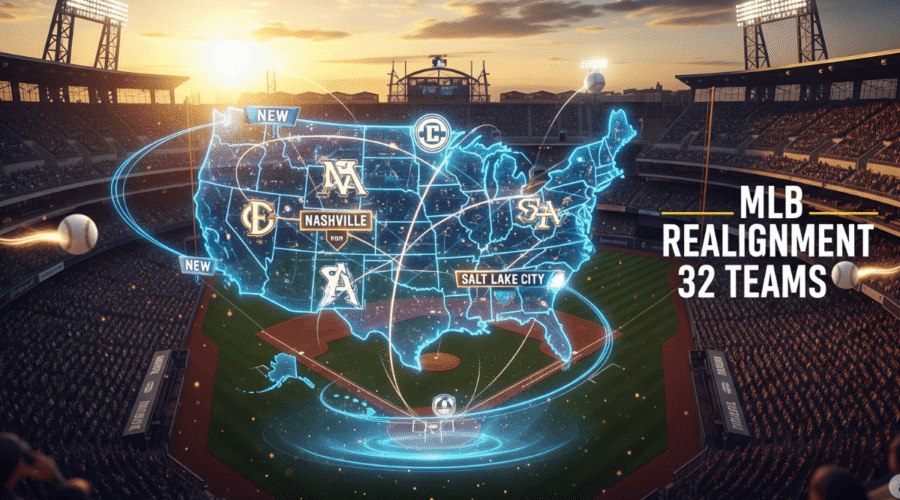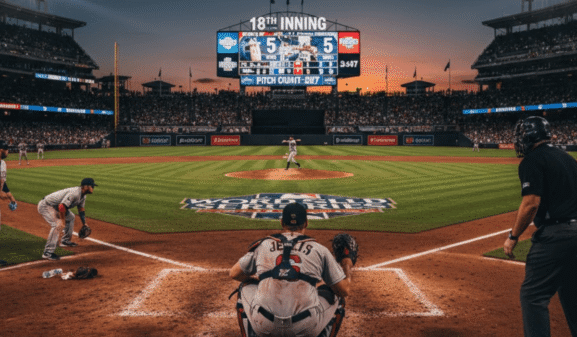MLB Realignment 32 Teams : Rumors & schedule updates that could reshape MLB rivalries
Major League Baseball stands at the precipice of its most significant transformation in decades. With Commissioner Rob Manfred actively discussing expansion to 32 teams and the inevitable realignment that would follow, baseball fans across the country are buzzing with predictions and speculation about how their favorite sport might look in the coming years. The rumors aren’t just idle chatter anymore—they’re becoming concrete possibilities that could reshape the entire landscape of professional baseball.
Quick Takeaways
- MLB expansion to 32 teams would likely trigger complete geographic realignment of all divisions
- Eight divisions of four teams each could significantly reduce player travel and fatigue
- Nashville and Salt Lake City emerge as frontrunner cities for expansion franchises
- Traditional American and National League structures may be preserved despite geographic shuffling
- Historic rivalries like Yankees-Red Sox could be maintained while improving regional competitiveness
- Commissioner Manfred aims to implement expansion process before retiring in 2029
The potential move to a 32-team league isn’t just about adding new cities to the MLB map. It represents a fundamental shift in how baseball could organize itself geographically, competitively, and economically. For fans who have grown accustomed to the current 30-team structure with its sometimes awkward divisional alignments, the prospect of geographic realignment offers both exciting opportunities and concerning disruptions to decades of established rivalries and traditions.
However, it’s important to note that while the momentum toward expansion appears strong, the specific outcomes remain largely speculative. The Tampa Bay Rays’ situation became particularly complex following Hurricane Milton’s destruction of Tropicana Field’s roof on October 9, 2024, rendering the facility unusable for the 2025 season. Recent developments indicate significant progress toward resolution—the team has reached an agreement in principle with Jacksonville developer Patrick Zalupski for a $1.7 billion sale, with the deal expected to close as early as September 2025. The new ownership group has committed to keeping the team in the Tampa Bay area.
The Commissioner’s Vision: Why Realignment Makes Sense
Rob Manfred has been vocal about his belief that expanding to 32 teams would “provide an opportunity to geographically realign” the league in ways that benefit players, owners, and broadcasters alike. His reasoning goes far beyond simple mathematics—though the scheduling advantages of eight four-team divisions instead of six five-team divisions are undeniable.
The current system forces teams like the Boston Red Sox to regularly travel to Anaheim for late-night West Coast games that alienate East Coast audiences. Similarly, West Coast teams find themselves playing afternoon games that conflict with their local fanbase’s work schedules. Manfred envisions a future where geographic proximity drives scheduling, creating more viewer-friendly time slots and reducing the physical toll on players who currently log hundreds of thousands of airline miles each season.
From a business perspective, the benefits extend beyond player welfare. Reduced travel costs would significantly impact team budgets, while improved television scheduling could boost broadcasting revenues. The 10 PM ET time slots that currently feature awkward cross-country matchups could instead showcase compelling regional rivalries that maintain audience engagement throughout the game.
Current MLB Realignment Ideas: Eight Divisions Under Consideration
While no official decisions have been announced, the most frequently discussed scenario involves restructuring MLB into eight four-team divisions, similar to the NFL’s current format. Commissioner Manfred has confirmed this approach would work better than the current five-team divisions from a scheduling perspective, stating “from a technical perspective it would be easier to divide the schedule up by four” and that “having five teams in the divisions is problematic from a scheduling perspective.”
Hypothetical AL Realignment Exercise: Baseball analysts have created theoretical American League configurations as thought experiments for geographic proximity. One purely speculative example would maintain an AL East with the Yankees, Red Sox, Blue Jays, and Orioles to preserve baseball’s most valuable rivalry. An AL West could hypothetically include Seattle, the relocated Las Vegas Athletics, the Los Angeles Angels, and a new expansion team—though this is entirely conceptual.
National League Geographic Theory: Industry observers have similarly theorized about National League improvements, though these remain academic exercises rather than confirmed plans. The NL West’s current Dodgers, Giants, Padres, and Diamondbacks already represent solid geographic clustering. Any future realignment would need to address various geographic inconsistencies, though no official roadmap exists for specific team movements between leagues or divisions.
Will MLB Expand to 32 Teams? The Timeline and Frontrunners
Manfred has stated he wants the league at 32 teams before retiring in 2029, making expansion a strong possibility within the next four years. However, the commissioner has consistently emphasized that expansion won’t occur until the Oakland Athletics and Tampa Bay Rays resolve their stadium situations.
The Athletics’ move to Las Vegas appears on track, with their new stadium construction progressing. The Rays’ situation became more complex after Hurricane Milton destroyed Tropicana Field’s roof in October 2024, rendering the facility unusable for 2025. However, recent developments suggest resolution may be near—the team entered exclusive negotiations with Jacksonville developer Patrick Zalupski for a $1.7 billion sale that could be completed by September 2025, with the new ownership planning to keep the team in the Tampa area.
Read more: MLB 2026 Home Run Derby Tickets Release Date Predictions and Insider Rumors
A sample configuration of eight four-team divisions under a 32-team realignment.
Northwest Division
- Mariners
- Giants
- Salt Lake City
- Rockies
West Division
- Dodgers
- Angels
- Diamondbacks
- Padres
South Division
- Rangers
- Astros
- Royals
- A’s
Southeast Division
- Rays
- Marlins
- Braves
- Nationals
East Division
- Yankees
- Mets
- Phillies
- Red Sox
Mid Division I
- Tigers
- Cubs
- Twins
- Nashville
Mid Division II
- Pirates
- Guardians
- White Sox
- Reds
Mid Division III
- Cardinals
- Brewers
- Blue Jays
- Orioles
Several groups are actively courting expansion franchises, with Nashville and Salt Lake City emerging as the strongest candidates based on market demographics, stadium funding commitments, and geographic logic. Austin has also gained momentum, with expansion groups there projecting entry fees could reach $2.25 billion. The predictions and rumors suggest these markets could support major league baseball while filling crucial geographic gaps in MLB’s current footprint.
MLB Division Realignment History: Learning from Past Changes
Baseball’s realignment history provides valuable context for understanding how future changes might unfold. The last major realignment occurred in 1994 when MLB moved to three divisions per league. The 2013 move of the Houston Astros from the National to American League was far more than a minor adjustment—it was a significant structural change that balanced both leagues at 15 teams each and created year-round interleague play for the first time in baseball history.
Each previous realignment faced resistance from traditionalists concerned about disrupting established rivalries and travel patterns. The Astros’ league switch, initially controversial, demonstrated that major structural changes could work effectively while creating new competitive dynamics. However, whether these changes improved competitive balance remains a subject of ongoing debate among baseball analysts.
The 2020 pandemic season offered a preview of geographic scheduling when teams primarily played divisional and corresponding geographic opponents. This experiment demonstrated that regional play could work effectively while maintaining competitive integrity and fan interest. However, it’s worth noting that the NFL’s realignment to eight four-team divisions required extensive planning and resulted in teams like Jacksonville, Tennessee, Houston, and Atlanta being placed into newly created South divisions, while Indianapolis moved to the AFC South—showing that even well-planned realignments don’t always achieve perfect geographic logic.
Read more: Red Sox 2026 Schedule Release Date: Predictions and Rumors for Boston Fans
What Are the 30 MLB Teams Today? Setting the Stage for 32
Currently, MLB’s 30 teams are distributed across six divisions of five teams each. This uneven structure creates scheduling challenges and competitive imbalances that expansion could resolve. The American League includes the East (Yankees, Red Sox, Blue Jays, Orioles, Rays), Central (Guardians, Twins, White Sox, Tigers, Royals), and West (Astros, Angels, Athletics, Mariners, Rangers).
The National League mirrors this structure with East (Braves, Marlins, Mets, Phillies, Nationals), Central (Cubs, Reds, Brewers, Pirates, Cardinals), and West (Diamondbacks, Rockies, Dodgers, Padres, Giants) divisions. The geographic inconsistencies are obvious—the Rockies in the “West” despite being Mountain Time, the Astros in the AL West despite being Central Time, and various teams separated from natural regional rivals.
A 32-team structure would address these inconsistencies while creating more balanced competitive environments. Four-team divisions would allow for more frequent intra-divisional play, strengthening regional rivalries while reducing travel burdens that currently affect player performance and team expenses.
The Future of Baseball: Balancing Tradition with Innovation
MLB’s expansion rumors represent more than simple arithmetic—they reflect baseball’s potential evolution into a more geographically sensible, economically efficient, and competitively balanced organization. However, these remain projections and theoretical benefits rather than guaranteed outcomes. The predictions surrounding realignment acknowledge that change is inevitable in professional sports, but the challenge lies in implementing improvements without destroying what makes baseball special.
Historic rivalries like Yankees-Red Sox, Dodgers-Giants, and Cubs-Cardinals would need to be preserved in any realignment scenario, as confirmed by industry insiders familiar with MLB’s thinking. These matchups drive television ratings, ticket sales, and fan passion in ways that purely geographic considerations cannot replicate. Any successful realignment would likely need to balance geographic efficiency with maintaining these established rivalries.
The addition of two new franchises also means 50 additional major league roster spots, expanded opportunities for player development, and new markets for baseball’s growth. Cities like Nashville and Salt Lake City bring passionate sports fans, modern facilities, and corporate sponsorship potential, though the actual impact on league strength remains to be seen.
Frequently Asked Questions
Q: When will MLB expand to 32 teams?
A: Commissioner Rob Manfred has expressed hope for an expansion process before his retirement in 2029, with actual expansion potentially occurring in the mid-to-late 2020s, contingent on resolving current stadium situations for the Athletics and Rays. However, no official timeline has been established.
Q: Which cities are most likely to get expansion teams?
A: Based on Commissioner Manfred’s public statements and industry reports, Nashville and Salt Lake City are frequently mentioned as strong candidates, with Austin, Portland, Charlotte, and Orlando also generating interest from MLB leadership and expansion groups. Austin expansion groups have projected entry fees could reach $2.25 billion.
Q: Would realignment eliminate the American and National Leagues?
A: Commissioner Manfred has not suggested eliminating the AL and NL structure. Most industry speculation focuses on maintaining league identity while reorganizing geographic divisions, though no official plans have been announced.
Q: How would historic rivalries be affected by realignment?
A: While no specific plans exist, preserving major rivalries like Yankees-Red Sox and Dodgers-Giants would likely be a priority in any realignment discussions, based on their importance to television ratings and fan engagement.
Q: What would 32-team realignment mean for the playoffs?
A: MLB’s current 12-team playoff format (expanded in 2022) features Wild Card Series with best-of-three formats. How expansion might affect playoff structure remains entirely speculative at this point.
Conclusion
The rumors and predictions surrounding MLB’s expansion to 32 teams represent more than speculation—they reflect a strategic vision for baseball’s future that prioritizes player welfare, fan engagement, and business efficiency.
While change always brings uncertainty, the thoughtful implementation of geographic realignment could strengthen baseball’s position as America’s pastime while expanding its reach into passionate new markets. As Commissioner Manfred works toward his 2029 timeline, baseball fans can expect these discussions to intensify, bringing us closer to witnessing the sport’s next great evolution.


